SHSU Cowboys, Alumni Hope For ‘Big Bucks’ At RodeoHouston
March 5, 2014
SHSU Media Contact: Jennifer Gauntt
Story By:
Linda Gilchriest
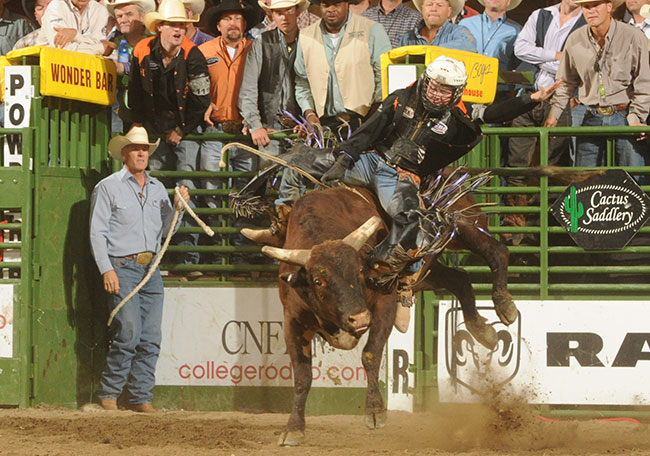 |
| Wearing a helmet has been a life-saving decision for bull rider and ag engineering major Trey Benton, who had a bull "rearrange his face mask on his helmet" and crush his eye socket during one ride. Despite undergoing facial reconstructive surgery last January, Benton still rides and will be among the SHSU rodeo athletes who will compete during RodeoHouston this year. —Submitted photos |
UPDATE (March 7): Caleb Smidt has placed second in tie-down roping and Taylor Price has placed fifth in bareback riding in the rodeo's first Super Series. To follow the results of SHSU's cowboys, click here.
UPDATE (March 18): Semifinal action begins tomorrow (March 19) and will include Smidt and bareback rider Evan Jayne, an SHSU alumnus (not featured in this article).
Country music legend Waylon Jennings may have gotten it wrong. Sometimes it’s great to let your babies grow up to be cowboys, especially if you are the parents of the cowboy—and cowgirl—talent at Sam Houston State University.
For the next few weeks, the spotlight will be on bareback riders Taylor Price and Bill Tutor, bull rider Trey Benton III and tie-down roper Caleb Smidt, all students or recent graduates of SHSU’s rodeo team who are competing at the Houston Livestock Show and Rodeo.
All are members of the Professional Rodeo Cowboys Association and the National Intercollegiate Rodeo Association. Although RodeoHouston is no longer a PRCA-sanctioned rodeo, it is world-renowned, and these four cowboys hope to take home part of the bounty offered there.
Price, who attended his first rider orientation Tuesday (March 4) at Reliant Park, said he is excited to compete in Houston.
“It is one of the richest rodeos in the world,” Price said. “I’m just excited to be here.”
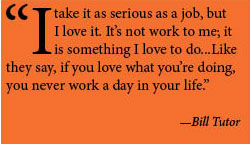 |
Price, a Huntsville native, is ranked among the top 25 bareback riders in the world by the PRCA. He is a 21-year-old criminal justice major at SHSU who is set to graduate this spring.
He first got into the rodeo game while a sophomore in high school.
“I had a girlfriend and her brothers rode bulls. They said they were going to beat me up if I didn’t get on a bull,” said Price, adding that he rode bulls for four years before concentrating on bareback riding.
Trey Benton III, 22, an ag engineering student, started riding calves at the age of 8, then moved onto bull riding where he has had much success.
Benton, who was a standout on the SHSU rodeo team, leading the team to the national finals in 2011, turned pro that same year. He finished fifth in the Texas Circuit Finals his rookie year and 10th in the all-American finals. He currently ranks third in the PRCA world standings and is third in the Xtreme Bull standings.
Benton is coming off what might have been a career-ending injury last year, thanks to a bull in Washington State.
“I actually rode him (the bull) in the shootout round and when I came off, he flipped on me and snapped my leg in half,” Benton said. “It still hurts to this day.”
After a four-hour surgery following the incident, Benton rode in the national rodeo finals in December before having another surgery to have a metal rod inserted into his leg.
Benton, like most rodeo cowboys, takes his injury in stride.
“I never get real nervous getting on a bull,” he said. “I’ve always been calm. It’s (bull riding is) just something that relaxes me, I guess. I’m pretty loose and cool; it’s not too much of a big deal.”
Smidt, a 2013 SHSU graduate with a degree in ag business, is a calf roper who will compete in his first Houston rope tie-down event. He is ranked second in the U.S. in the PCRA world standings and second in the Wranglers Million Dollar Tour Standings. During his rookie year in the pros, Smidt earned $81,824 and the PRCA selected him “Resistol All-Around Rookie of the Year.”
Smidt, who lives with his wife, former PRCA barrel racer Brenna Byler, in Bay City, began roping “as soon as I could walk and ride a horse. I remember riding a little pony.”
Although he has earned $130,000 since turning pro, he said college rodeos are hard to win.
“Sometimes the calves and steers aren’t as good as you’d want them to be,” Smidt said. “There are only 10 schools in our region, and they each have a rodeo. They just take the top three to the college finals. As a pro, we have 75 rodeos to go to, so you can win more at 75 rodeos. With only 10 rodeos, you have to make sure you do good to make the college finals.”
Tutor was the last SHSU cowboy invited to RodeoHouston after his bareback win in San Angelo on March 2. No one is more excited to be there, he said.
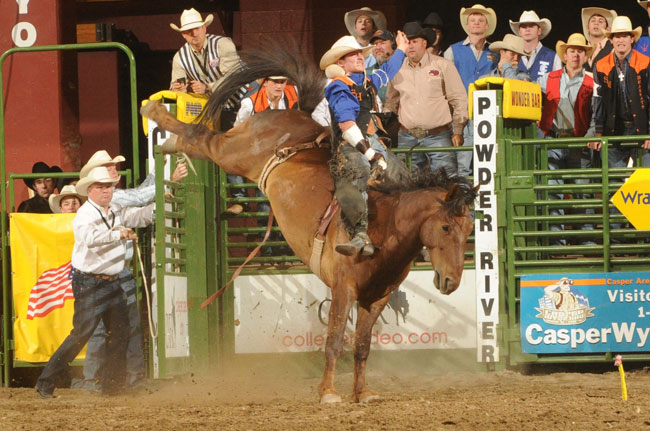 |
| Bill Tutor has made a name for himself both inside and outside of the classroom, a distinction that has earned him “National Intercollegiate Rodeo Association All American” honors. |
“I always wanted to compete in Houston,” Tutor said. “It is one of the riches rodeos in the world.”
Tutor came from a rodeo family.
“My dad got me into it. He roped when I was growing up,” Tutor said. “He just kind of pushed me into it. He rode some bareback horses when he was young. He was the one who talked me into getting on some bucking horses.”
The four Houston competitors have been honing their skills since they were youngsters; Price was the only cowboy to get into his sport while in high school.
They all say they love the sport and work hard to show off their talent.
“I take it as serious as a job, but I love it,” Tutor said. “It’s not work to me; it is something I love to do, but I take it just as seriously as anybody would with a job. Like they say, if you love what you’re doing, you never work a day in your life.”
Head rodeo coach Edward “Bubba” Miller said he’s excited to see how his cowboys do at RodeoHouston.
Miller has been rodeo coach at SHSU for six years, after having a successful 10-year career on the professional circuit. He knows the rigors of the sport because he did it himself.
SHSU’s rodeo team has 87 students, 40 percent of whom are women.
“Girls in college rodeo can compete in barrel racing, breakaway calf roping and goat tying,” Miller said. “In that event, a goat is staked out at the far end of the arena. They ride their horses to within 10 feet of the goat, dismount and hog-tie the goat. This normally takes between six and seven seconds. I don’t know about you, but I can’t tie my shoes between six and seven seconds.”
While rodeo is widely known for its element of danger, Miller said one of the biggest changes he has seen in the competition is improvements in safety.
“I really believe anyone will tell you that the rodeo athlete is a lot safer with the use of the helmet as well as with the protective vest,” he said.
“Trey Benton had a bull rearrange his face mask on his helmet. The bull did crush his eye socket, and he had to have facial reconstructive surgery last January. Without that helmet, Trey probably would have been killed. I believe the helmets and the vests have saved many a rodeo athlete’s life.”
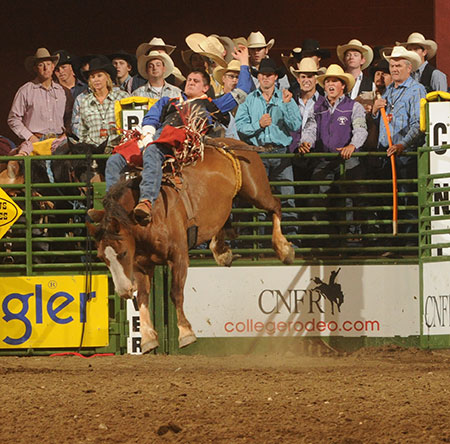 |
| Huntsville native Taylor Price is excited to be participating in RodeoHouston for the first time. The 21-year-old criminal justice major is ranked among the top 25 bareback riders in the world by the PRCA. |
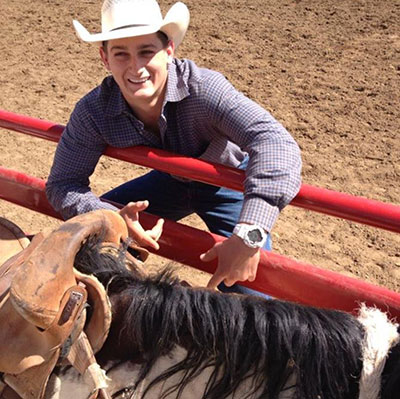 |
Benton uses a helmet while bareback riders Tutor and Smidt prefer what they call comfort vests that have soft leather across the chest and strong support features along the neck and back. When the horse is bucking, it creates almost a whiplash effect, Miller said, which can cause injury to the neck, back and shoulders.
Another big change is in the name. The college rodeo cowboy is now a “rodeo athlete,” and for a good reason, Miller said.
“These guys train in the gym every day. They eat right; they are on vitamin complexes,” Miller said. “They are lean; they’re cut; the have six-packs. These guys are machines. There’s no doubt they are athletes. There is no reason to call them anything else.”
Most practice a few times a week and study videos of their practices to see what went wrong.
Smidt said he is practicing every day right now.
“It’s not like you can practice for a year, get it figured out and never have to practice again,” Smidt said. “I’ve been practicing since I was 5 years old, and I still have problems with it today. I think with every practice session, you can get better.”
Price said he looks forward to competing, but he still can get nervous before a ride when he sees the horse bucking around in the shoot. He still gets the adrenalin rush from riding, even after seven years.
Tutor said rodeo athletes thrive on the fast pace and heart-thumping competitions provides.
“You love riding bucking horses, but when you spur one to the best of your ability and you ride that horse the best you can, when you get off, there is no better feeling than knowing you rode that horse next to perfect,” Tutor said. “It just feels good when you ride them right. It makes you want to get on more horses and more horses.”
Rodeo is one of the most individually competitive sports around, but all four of the SHSU cowboys said the sport also breeds a brotherhood.
“When I go to rodeos, of course I want to beat them, but I want them to ride the best that they can. Then I have to be even better than that,” Tutor said. “Nobody wishes for anybody to buck off or ride bad. You’re rooting for each other. It’s a big family, that’s what it is.”
.
- END -
This page maintained by SHSU's Communications Office
Associate Director: Julia May
Manager: Jennifer Gauntt
Located in the 115 Administration Building
Telephone: 936.294.1836; Fax: 936.294.1834
Please send comments, corrections, news tips to Today@Sam.edu.

 SamWeb
SamWeb My Sam
My Sam E-mail
E-mail

